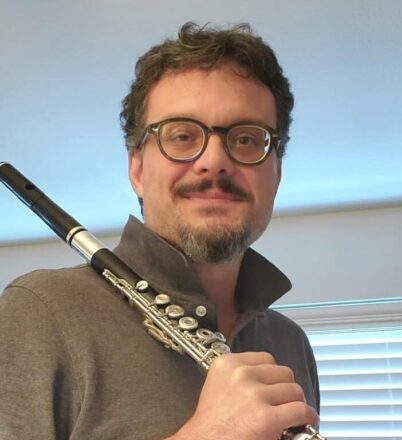
by Sergio Pallottelli
The issue of phrasing is a difficult matter as it is mostly personal and unique to every musician. What makes the difference between what we call a “well phrased” performance versus the opposite? It is difficult to put one’s finger on specific issues, but when the phrasing is right we all notice it and appreciate it greatly, whether we are trained musicians or not.
If you wish to explore and deepen this aspect of your playing, here are some tips I can offer on how to listen and perform more carefully, so that there is more “meaning” and direction in your playing.
Phrasing is made up of different elements, such as flow, taste, silence, intelligence, tenderness, dynamic contrast, flexibility and gestures, just to mention a few.
- Be curious
- Listen to lots of genres of music by different performers
- Study the works of Bach, Haydn and Mozart
- Experiment gestures and ideas in your own playing
Be curious
Curiosity is the spark and essential element in one’s musical development. Stay curious throughout your career and your playing will have a fresh and innovative sparkle as you mature as a player. Remember maturing never ends. As a young player listen to recordings and even better live concerts of performers of your instrument. Develop a taste for what sound you like or don’t.
However, don’t stop there, expand to other instruments. We tend to hear music differently, when listening to instruments that are not our own. When hearing a different instrument than yours perform, listen intelligently. Compare what happens sound-wise, dynamically, projection- wise and color-wise, with the instrument you are hearing versus if it were your own. How would you play it? If listening to a larger work such as orchestral repertoire, or a choir, get the music, the score, and play sections of it.
Other than being fun, this kind of study opens your eyes and ears to new possibilities and makes you aware to why a singer will hang on to certain notes, why a string player will need more time on a certain passage, why a pianist is so rhythmically free yet so accurate, why an oboist projects so well in most situations. This curiosity will make you change your way of approaching your repertoire and the way you play the nuances on your instrument. It will happen consciously and subconsciously. The subconscious part comes first, because as humans we react to things, sensations and emotions. Developing this reaction into a thoughtful sense-of-taste is the conscious process, where we use our musical intellect and intelligence.
This curiosity will shape you as a human and as a musician, which will give a tone and pace to your playing. The same happens when one speaks in different ways, depending on whom we are talking to and what we are talking about. The speed of our sentence, the intensity of it, the places we pause between words, the emphasis we give to certain places of the sentence, are what we call phrasing.
Listen to lots of genres of music by different performers
As in most things, the more open minded we are the better we do in our own living and being. Explore and listen to other genres of music, such as jazz, folk, bluegrass, pop or whatever it is that may interest you. Listen with classical ears and get to know why different kinds of music are different. Try to listen to what it is that makes a certain genre unique. Find similarities. You will find that jazz players deal with the same kind of phrasing issues we do, they make tasteful decisions and sometimes not so tasteful ones. The same applies to pop singers. Who really speaks to you? Who touches your heart? Search for answers as you are opening your mind to a broader palette of possibilities in your own playing.
Personally I learned so much from listening to Latin jazz and understanding the different rhythms. I studied the “clave” culture, and how a clave fits our western music meter. I learned, and continue to do so, how Salsa and Mambo unfold, and what elements make them distinct. Suddenly playing difficult rhythms in my own classical world was much easier, because my mind was open to a new way of thinking. The clave is basically a beat that one dances to, different from the traditional meter that is present in the melody and harmonic structure of a piece. The different influences and the different characteristics of music help one make intelligent decisions when it comes to where to breathe and not disrupt the music, rhythmically and harmonically.
Always study the rhythmic patterns and know how your harmonic structure unfolds, before you make your final phrasing decisions. Sometimes, what you wish to do instinctively does not make sense, once you hear the harmony accompanying your part. To acquire this kind of knowledge and to have this deep understanding of the music one is playing one should expand ones horizons to as many different types of music as possible. You may like some, you may think others are not so interesting, but they all add to the development of your musical taste and finesse.
Study the works of Bach, Haydn and Mozart
Time to leave the conceptual and get down to concrete matters. I recommend the study of the music of Haydn, Mozart and Bach, more than anything for developing a fine and intellectual sense of phrasing. Listen to Mozart violin sonatas, piano sonatas, concertos and above all his operas. The structure and pure beauty in Mozart operas is pure genius. Listen to Cosi fan tutte, Don Giovanni or Marriage of Figaro, and realize how carefully each duet, each instrumental exchange are set up. Follow the words in the score as you are listening, and see how the music matches them perfectly. Eventually you will notice that all of Mozart’s music is influenced by his operatic writing. His flute concerto, the Clarinet quintet, his piano concertos and his violin sonatas, are all “mini” operas with different roles present. In the Bach opus, pretty much anything will be of guidance and revealing the infinite possibilities in how to phrase a certain passage. I still find new elements in the Partita in A minor for solo flute that make me rethink how I phrase the piece. I use Robert Stallman’s volumes of Bach studies, collections of Bach works for cello, keyboard and violin, all transcribed for the flute, for study purpose. These are not necessarily meant to be performed but simply including the reading of one Bach work every day, furthers your knowledge and taste progressively. I see it sort of like taking vitamins daily, one doesn’t notice the difference, but they are good for your immune system in the long run. Study Haydn String Quartets, piano works and sonatas for violin. Haydn’s music is so clear and obvious in a certain sense, that it is ideal for experimenting. The rules are clear and beautifully traditional, so that a wrong breath or an unwanted stress on any part of the measure is of great disturbance even to the untrained ear.
In time, as you get accustomed to the style of this period (late 1600s to late 1700s) you will find yourself breathing with the music in a way that makes sense. If the breaths fall in correct places, the stress of your musical sentence will also be correct and the meaning of what you are trying to say will be deep and personal.
Experiment gestures and ideas in your own playing
Lastly, you should apply all the sensations and ideas to your own playing. The only way to do this is to take risks and not be afraid to make mistakes. Imitating a certain performance, or breathing a certain way that you heard previously on a recording or live performance can be a good start.
However, trying your own ideas out is of greater importance. Risk having a colleague or teacher tell you it “is wrong”, but try to sell your thought and ideas. Begin with obvious gestures that are idiomatic on your instrument. On flute, the sound naturally gets louder as you get into the high register and softer in the lower one. Staccato passages have a certain flare, different from a legato passage.
Play into these differences, following the natural tendencies of your instrument. Then, venture into dynamic range, experimenting with more difficult nuances to execute. Remember there is always a way, as long as you have a clear idea of where you wish the music to go. Breathe in several spots, until you decide on the ideal location for a breath. This also might take making a few errors in the beginning of your study. Be patient, open minded and adventurous as the journey will lead you to new and interesting concepts.
Practice as if you were practicing a speech in front of a mirror, trying to give the right inflection and tone to your sentence, as well as the facial expressions you would associate with certain ideas. Music works the same way, you have to plan and practice every single detail, to make your interpretation unique to you, which is ultimately what sets us apart from other musicians. Our performing style is defined by each gesture and by the little things just like our personality.
Helpful guidelines:
• Try not to breath on bar lines in general. The musical phrase usually starts before the next measure and goes to the next measure. (There are exceptions)
• Think of your breaths as part of the musical line.
• Always practice taking the breath as if you were practicing a difficult passage; one must practice taking breaths in the spots we place them, especially the quick ones.
• Go for longer phrases in general. Long phrases let the music flow more naturally.
• Remember that sometimes there can be silence without a breath.
• Remember that sometimes there can be sound still ringing through a breath.
• There is always more than one phrasing option. • Your choices will change in time, whether over a day or a few years.
• Observe all markings in music as they always indicate what should happen. It is your job to search deeper and make your interpretation unique.
• Play through all music very slowly, even when you have learned it. Every time you will find a new
Sergio Pallottelli
Sergio Pallottelli performed in Europe, Australia, US and South America, where he has developed a deep passion for the music of Chile, Argentina, Ecuador, Brazil, Peru, Mexico, Colombia and Venezuela. Adjunct flute faculty at University of Bridgeport as well as at the prestigious Taft School, since 2017 he is Professor of Flute at Longy School of Music of Bard College, in Boston.








Bravo, totalmente d’accordo.
Sono concetti che possono chiarire molto, soprattutto ai giovani, l’idea dello “studio”.